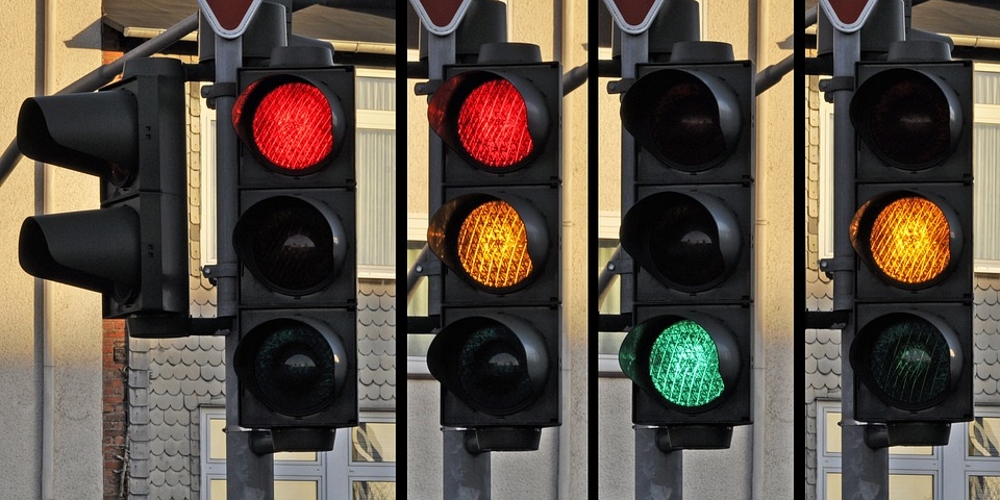
The first traffic lights were installed outside the Houses of Parliament in 1868. Modern-style traffic lights were invented in the USA in 1912.
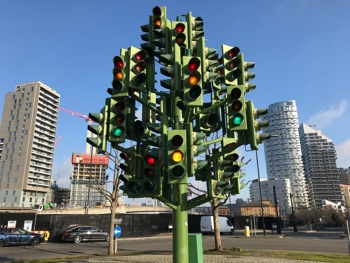 The picture shows a 'traffic light tree' sculpture in London. You will encounter different and sometimes complex lights - although not as complex as the lights shown in the picture.
The picture shows a 'traffic light tree' sculpture in London. You will encounter different and sometimes complex lights - although not as complex as the lights shown in the picture.
There are different traffic light systems worldwide, but they all have one thing in common:
Red means STOP!
Unless you are faced with an emergency situation, you must always obey the traffic lights - this means that you can only go through the lights when they are green (and only then if it is safe to do so).
You must always obey the traffic lights - this means that you can only go through the lights when they are green (and only then if it is safe to do so).
This lesson covers all UK traffic lights, except pedestrian crossing lights, which are covered in the pedestrian safety lesson.
Traffic lights aren't the only time you are 'controlled' - police and traffic wardens can also request you to stop.
Signals given by people controlling traffic are also covered in this lesson.
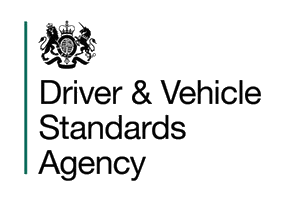 You will almost certainly encounter junctions and other situations controlled by traffic lights during your test.
You will almost certainly encounter junctions and other situations controlled by traffic lights during your test.
Depending on where you live, these could range from busy junctions with filter systems to simple temporary lights at road works.
Depending on the time of your test, you might also come across a school crossing patrol or other traffic control situation - perhaps at traffic lights that are out of order.
Things the examiner will consider:
Your use of the MSM routine on the approach
Whether you stop when necessary
Your position when stopping at traffic lights
The way you respond to people controlling traffic
Your lane discipline in accordance with filters
Your response to filter lights
Standard traffic lights in the UK always follow the same sequence.
Starting with red the sequence is: Red, Red and Amber, Green, Amber, Red.

Red means that you must stop and wait behind the stop line. As you approach, check your mirrors - has the driver behind seen the light?
Slow down early and be prepared for the lights to change. If the light is red when you arrive, stop behind the stop line.

Red and amber showing together alert you that the lights are about to change to green. If the lights are red and amber as you approach, time your arrival so that they are green when you get there.
You must not cross the stop line until the lights have changed to green. When red and amber show, prepare to move and check your mirrors.

Green means that you can move off if the way is clear and safe to do so. Look out for pedestrians, and for traffic that might go through red lights on the other roads. For example, emergency vehicles may proceed against a red light.
Always check your mirrors before moving, especially when turning left (look for cyclists) or on a road with more than one traffic lane (look for other road users who may change lanes).

Like red, amber means STOP.
You may only proceed at a steady amber traffic light if you have crossed the stop line or are so close to it that stopping might cause an accident (the rules are different for flashing amber lights - see pedestrian crossings for details).

We cover this in the Pedestrian Crossings lesson in the context of dealing with pedestrians.
Here we are looking at it in the context of traffic light-controlled junctions.
If you encounter a set of traffic lights which are out of order, treat the situation as an unmarked junction - no one has priority in this situation, so proceed with extreme caution, and in particular, watch out for pedestrians.
While it's important to be slow and careful, it's equally important to avoid hesitancy. Make eye contact with other drivers when possible and move through the junction positively if the way is clear - but you must always be prepared to stop.
If you come across a set of temporary traffic lights that are not working, the lights may only be out at your end of the controlled section of the road. Be aware that vehicles could be coming the other way - and won't be expecting to see you!
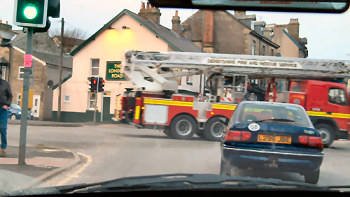
The photo (seen earlier in the Hazard Routine lesson) was taken during a training session and shows a fire engine going through a red light.
Just because the lights are green, you can't automatically assume that it will be safe to drive through – always check the other roads.
Fire engines aren't the only vehicles you might encounter; you might also see police cars, ambulances, coast guard, military or other emergency vehicles. Sometimes cyclists take their life into their hands by ignoring red lights.
And then there are the bank robbers.
Unlike professional emergency drivers, bank robbers won't care about your safety or anyone else's - they are likely to be in a stolen car and only interested in getting away. The good news is that you might get a reward if you spot them!
Of course, we can add to the list - joyriders, drunk drivers, drugged drivers or maybe just distracted drivers.
Glancing into the other roads before crossing the junction will reduce your risk of being involved in someone else's accident.
At some traffic light junctions, you will see a green filter arrow. If the road is clear and safe, you can move in the direction of the arrow. You can do this even if a red light shows for other directions.
If you drive into a filter lane by mistake, and the filter light comes on, you should carry on and turn around later rather than hold up the following traffic.
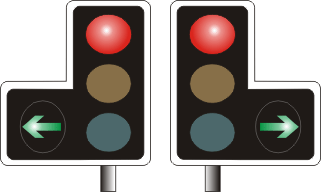
When you see this type of filter, you can turn in the direction of the arrow but must wait behind the stop line if you wish to go in any other direction.

When a green light and green arrow show together, you can go in any direction. The arrow for a right turn indicates that traffic coming the other way has a red light - but always make sure that approaching drivers are stopping before you proceed
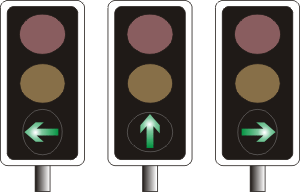
Sometimes there will be a single arrow instead of a green light. In these situations, you are only permitted to travel in the direction of the arrow.
For example - the centre light above shows that you can only go ahead with no left or right turn.
These lights will often have additional signs such as 'ahead only' or 'no right/left turn'
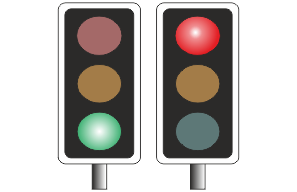
Occasionally you will come across a 'double' set of lights instead of a filter. These usually control right turns on busy roads with a physically separated lane for right-turning traffic.
This example shows that you can go ahead or turn left but cannot turn right until a green light or arrow shows on the right.
Whenever you encounter a junction with more than one lane in your direction, especially where there are filter arrows, you must get into your intended lane early. Look for road markings and information signs showing which lane you should take.
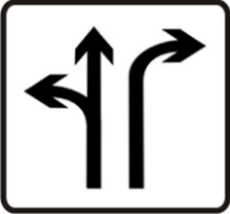
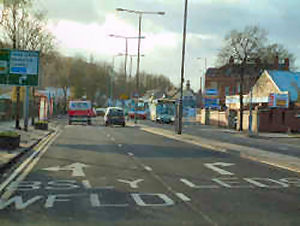
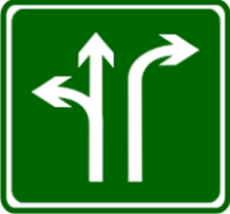
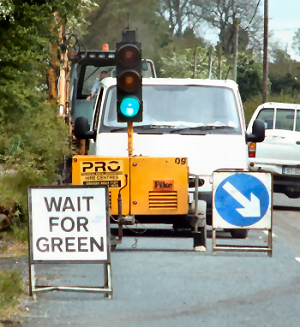
Temporary traffic lights at road works have the same meaning as fixed lights.
It is illegal to go through a red light at temporary lights, even if you can see the road is clear or if another driver signals to suggest that the lights in the opposite direction have turned red.
Although it shouldn't be necessary, the reminder notice in this photo suggests that some people take dangerous risks at temporary lights.
Temporary lights will also have a red sign with white lettering, ' When red light shows, wait here.' This sign replaces the stop line found at permanent traffic lights.
Sometimes the 'wait here' sign is quite a long way back from the lights - this is to allow plenty of space for large vehicles to manoeuvre as they come towards you.
Many temporary lights now have countdown clocks showing how long it will be until the lights change.
Remember. Red always means STOP!
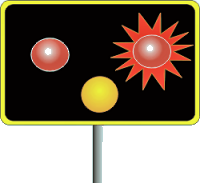
Lights outside emergency vehicle depots help ensure the safety of 'blue light' crews. You will find these at some fire stations, ambulance stations and coast guard stations
These lights have a single amber light and two red lights (like railway crossing lights).
The amber light has the same meaning as amber at standard lights - stop unless it is unsafe to do so.
The flashing red lights indicate that you must stop. There is not always a 'stop line', so you need to use common sense and stop at the location of the lights (there will often be a 'yellow box' or 'keep clear' markings).
The red lights flash alternately.
Occasionally these lights are arranged like a standard traffic light (vertical), but with two red lights, one at the top and the other replacing green at the bottom. These are used if there is not enough space to fit regular lights.
You can proceed when the lights go off if the road is clear and it is safe to do so.
Over recent years there has been increasing use of illuminated traffic signs to warn drivers about speed limits and other hazards.
These often have flashing amber lights on top and bottom to alert you to the danger ahead (like the amber lights on some motorway signs).
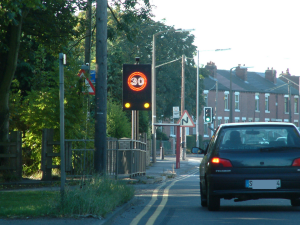
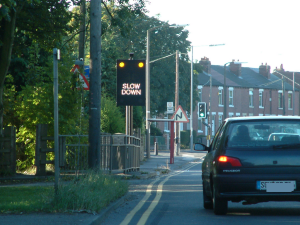
Trams have their own traffic lights, often attached to regular traffic lights – see the example – tram lights do not affect other road users but will alert you to the fact that trams use the junction.
You might think that it should be obvious that there are trams because of the tram lines, but at a strange junction, a very large junction or perhaps at night, tram lines crossing the road ahead might not be as clear as you might think - that’s when knowing about the lights is useful for car drivers.

The top light indicates that there are trams at this junction.
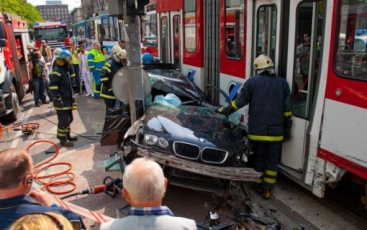
Take care... When cars fight with trams, the trams always win.
There will be times when you encounter the police, Traffic Officers , DVSA Officers or traffic wardens controlling traffic. You must obey the signals that they give you.
In fact, if you come across anyone controlling traffic, even if they are not doing it officially, it is wise follow their directions. For example, at the scene of an accident. However, always look for problems if an 'unauthorised person' controls traffic - don't assume it is safe to proceed just because they wave you through.
For your own security, you need to be aware of a potential personal security issue regarding people signalling you to pull over, stop or turn into a road or car park. If the person directing traffic is not a uniformed police officer or traffic warden and you are unsure about the situation, lock your doors and windows and be prepared to drive on.
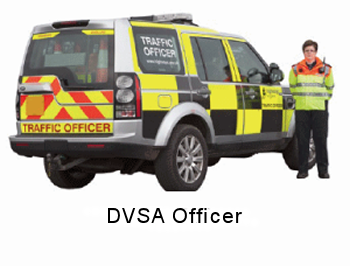
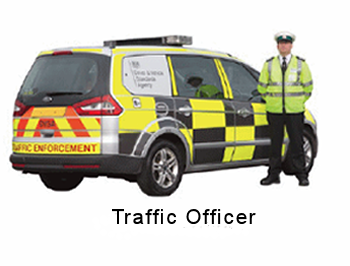
The illustrations below show the official signals given by traffic controllers.
The first three, illustrating a female officer, show that you must stop. The second three show a male officer beckoning a driver to proceed - you can proceed in the direction indicated by the officer.
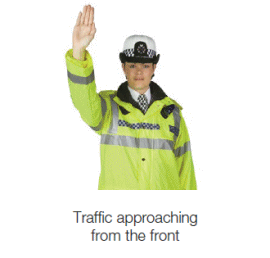


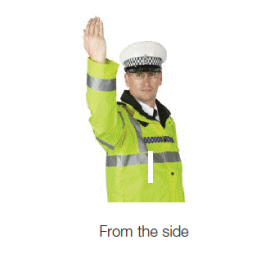
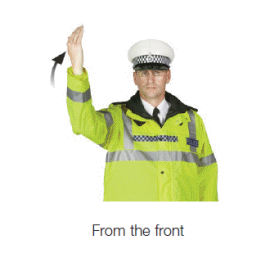
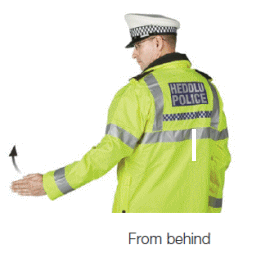



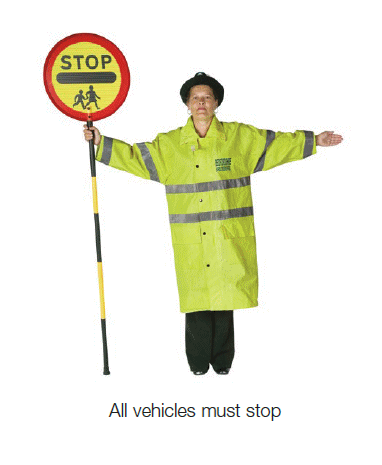
 Traffic Lights Quiz...
Traffic Lights Quiz...Click here to complete the quiz for this lesson
(The page will open in a new window/tab)
You will find references for the answers in this lesson.
You can check your answers as you go along, or complete the full quiz before checking.
Leaving the check to the end is a good way to test yourself.
When you check or review your answers you will get a brief explanation of the answer.
Good Luck!